Legal Analysis: Contracts, Estoppel, Negligence, and Consumer Law
VerifiedAdded on 2020/03/16
|8
|1582
|52
Homework Assignment
AI Summary
This document presents a comprehensive analysis of several legal issues. It begins by examining a contract law case, exploring the concepts of duress and undue influence, and determining whether a contract can be avoided. The analysis then shifts to a promissory estoppel case, assessing whether a promise can be enforced despite the absence of consideration. Next, the assignment delves into a negligence case, evaluating liability and the applicability of contributory negligence as a defense. Finally, the document considers the rights and remedies available under the Australian Consumer Law (ACL) in relation to false and misleading statements. Each issue is thoroughly addressed, referencing relevant legal principles and case law to support the conclusions. This assignment is a valuable resource for students studying contract law, tort law, and consumer protection.
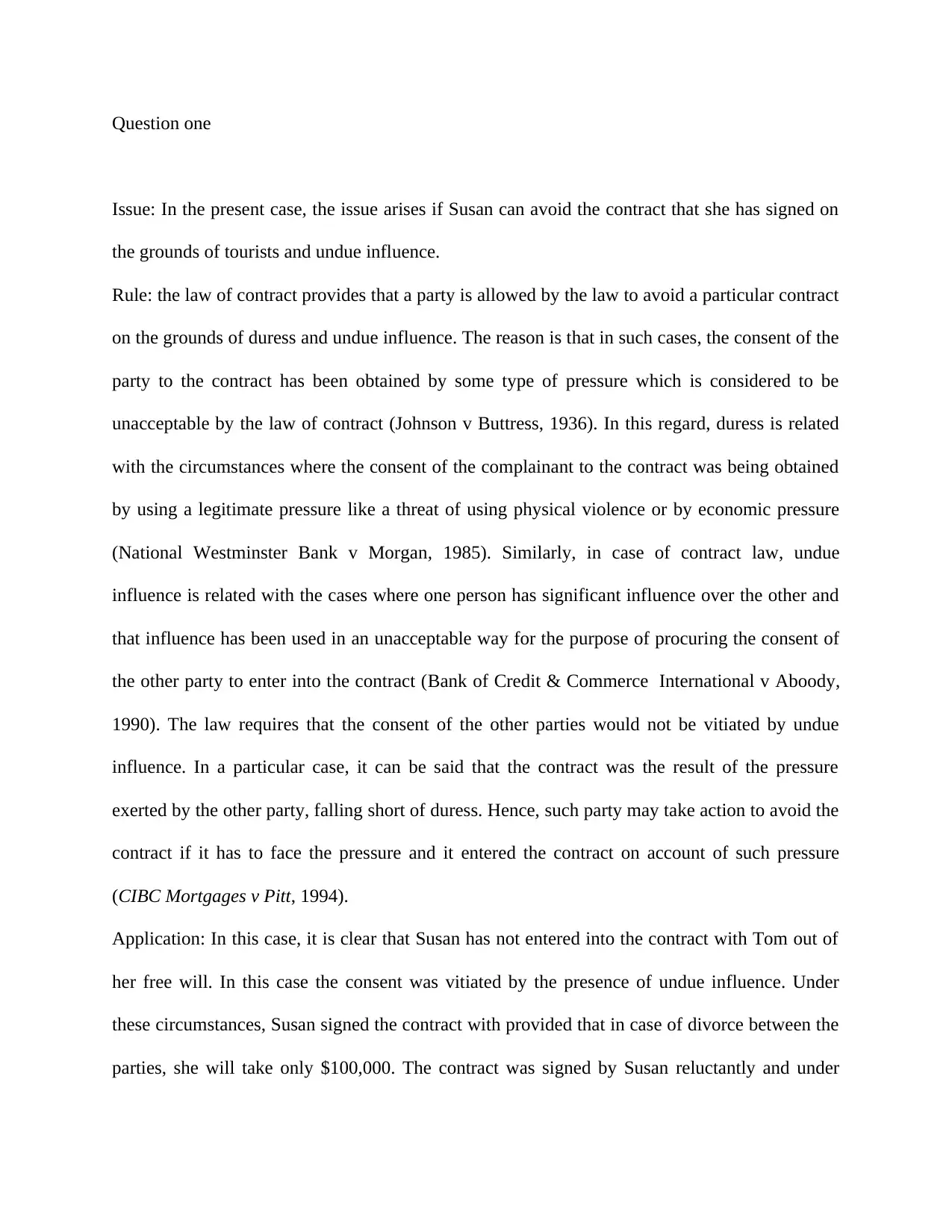
Question one
Issue: In the present case, the issue arises if Susan can avoid the contract that she has signed on
the grounds of tourists and undue influence.
Rule: the law of contract provides that a party is allowed by the law to avoid a particular contract
on the grounds of duress and undue influence. The reason is that in such cases, the consent of the
party to the contract has been obtained by some type of pressure which is considered to be
unacceptable by the law of contract (Johnson v Buttress, 1936). In this regard, duress is related
with the circumstances where the consent of the complainant to the contract was being obtained
by using a legitimate pressure like a threat of using physical violence or by economic pressure
(National Westminster Bank v Morgan, 1985). Similarly, in case of contract law, undue
influence is related with the cases where one person has significant influence over the other and
that influence has been used in an unacceptable way for the purpose of procuring the consent of
the other party to enter into the contract (Bank of Credit & Commerce International v Aboody,
1990). The law requires that the consent of the other parties would not be vitiated by undue
influence. In a particular case, it can be said that the contract was the result of the pressure
exerted by the other party, falling short of duress. Hence, such party may take action to avoid the
contract if it has to face the pressure and it entered the contract on account of such pressure
(CIBC Mortgages v Pitt, 1994).
Application: In this case, it is clear that Susan has not entered into the contract with Tom out of
her free will. In this case the consent was vitiated by the presence of undue influence. Under
these circumstances, Susan signed the contract with provided that in case of divorce between the
parties, she will take only $100,000. The contract was signed by Susan reluctantly and under
Issue: In the present case, the issue arises if Susan can avoid the contract that she has signed on
the grounds of tourists and undue influence.
Rule: the law of contract provides that a party is allowed by the law to avoid a particular contract
on the grounds of duress and undue influence. The reason is that in such cases, the consent of the
party to the contract has been obtained by some type of pressure which is considered to be
unacceptable by the law of contract (Johnson v Buttress, 1936). In this regard, duress is related
with the circumstances where the consent of the complainant to the contract was being obtained
by using a legitimate pressure like a threat of using physical violence or by economic pressure
(National Westminster Bank v Morgan, 1985). Similarly, in case of contract law, undue
influence is related with the cases where one person has significant influence over the other and
that influence has been used in an unacceptable way for the purpose of procuring the consent of
the other party to enter into the contract (Bank of Credit & Commerce International v Aboody,
1990). The law requires that the consent of the other parties would not be vitiated by undue
influence. In a particular case, it can be said that the contract was the result of the pressure
exerted by the other party, falling short of duress. Hence, such party may take action to avoid the
contract if it has to face the pressure and it entered the contract on account of such pressure
(CIBC Mortgages v Pitt, 1994).
Application: In this case, it is clear that Susan has not entered into the contract with Tom out of
her free will. In this case the consent was vitiated by the presence of undue influence. Under
these circumstances, Susan signed the contract with provided that in case of divorce between the
parties, she will take only $100,000. The contract was signed by Susan reluctantly and under
Paraphrase This Document
Need a fresh take? Get an instant paraphrase of this document with our AI Paraphraser
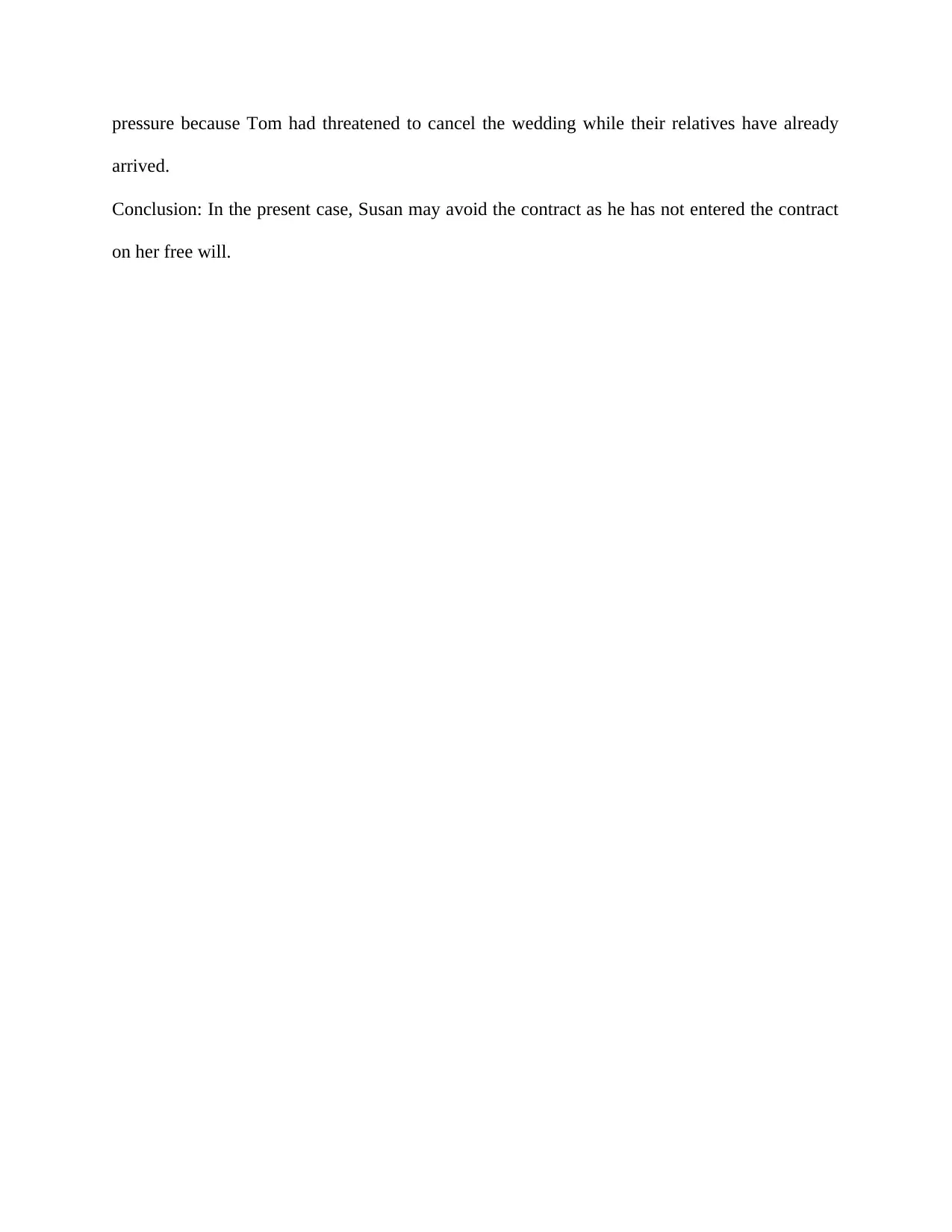
pressure because Tom had threatened to cancel the wedding while their relatives have already
arrived.
Conclusion: In the present case, Susan may avoid the contract as he has not entered the contract
on her free will.
arrived.
Conclusion: In the present case, Susan may avoid the contract as he has not entered the contract
on her free will.
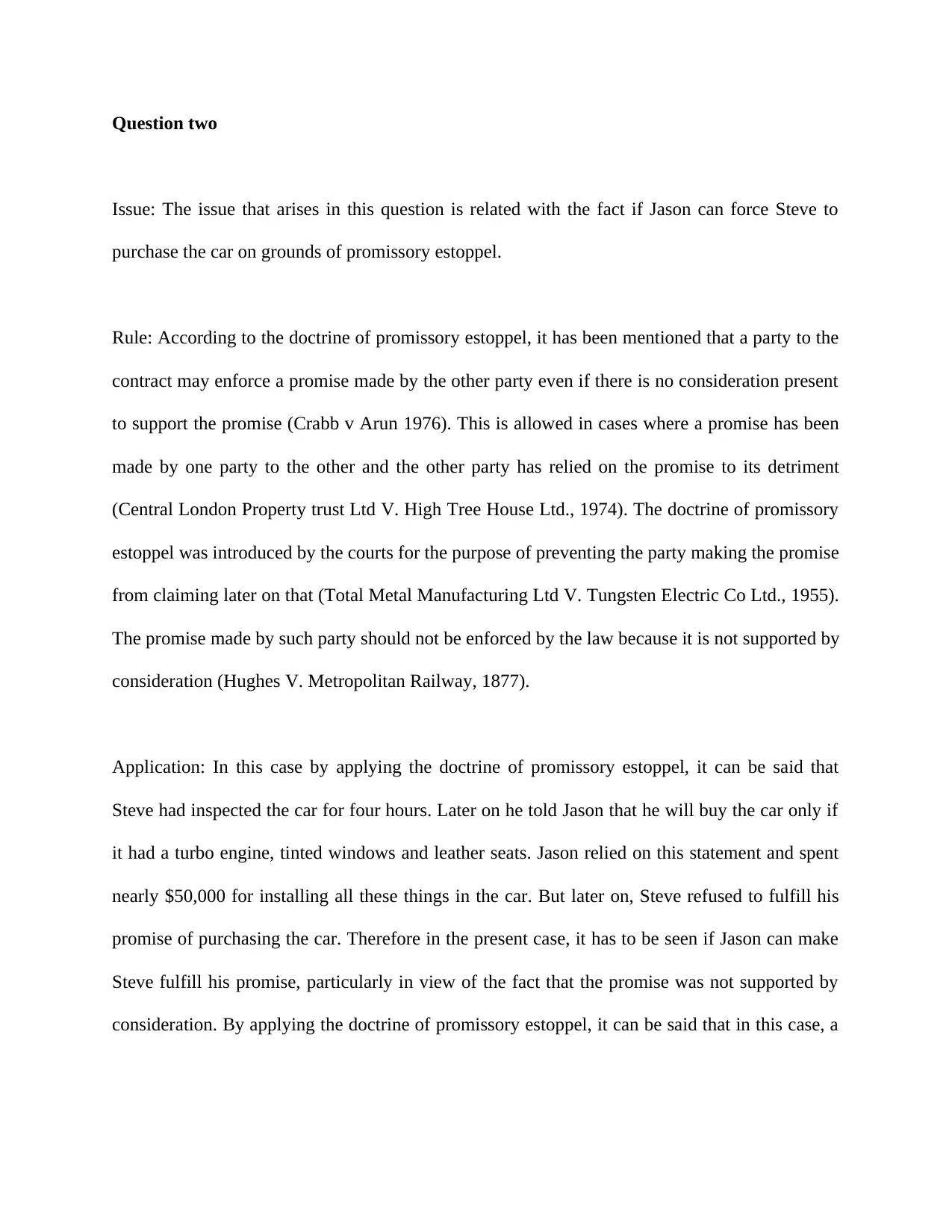
Question two
Issue: The issue that arises in this question is related with the fact if Jason can force Steve to
purchase the car on grounds of promissory estoppel.
Rule: According to the doctrine of promissory estoppel, it has been mentioned that a party to the
contract may enforce a promise made by the other party even if there is no consideration present
to support the promise (Crabb v Arun 1976). This is allowed in cases where a promise has been
made by one party to the other and the other party has relied on the promise to its detriment
(Central London Property trust Ltd V. High Tree House Ltd., 1974). The doctrine of promissory
estoppel was introduced by the courts for the purpose of preventing the party making the promise
from claiming later on that (Total Metal Manufacturing Ltd V. Tungsten Electric Co Ltd., 1955).
The promise made by such party should not be enforced by the law because it is not supported by
consideration (Hughes V. Metropolitan Railway, 1877).
Application: In this case by applying the doctrine of promissory estoppel, it can be said that
Steve had inspected the car for four hours. Later on he told Jason that he will buy the car only if
it had a turbo engine, tinted windows and leather seats. Jason relied on this statement and spent
nearly $50,000 for installing all these things in the car. But later on, Steve refused to fulfill his
promise of purchasing the car. Therefore in the present case, it has to be seen if Jason can make
Steve fulfill his promise, particularly in view of the fact that the promise was not supported by
consideration. By applying the doctrine of promissory estoppel, it can be said that in this case, a
Issue: The issue that arises in this question is related with the fact if Jason can force Steve to
purchase the car on grounds of promissory estoppel.
Rule: According to the doctrine of promissory estoppel, it has been mentioned that a party to the
contract may enforce a promise made by the other party even if there is no consideration present
to support the promise (Crabb v Arun 1976). This is allowed in cases where a promise has been
made by one party to the other and the other party has relied on the promise to its detriment
(Central London Property trust Ltd V. High Tree House Ltd., 1974). The doctrine of promissory
estoppel was introduced by the courts for the purpose of preventing the party making the promise
from claiming later on that (Total Metal Manufacturing Ltd V. Tungsten Electric Co Ltd., 1955).
The promise made by such party should not be enforced by the law because it is not supported by
consideration (Hughes V. Metropolitan Railway, 1877).
Application: In this case by applying the doctrine of promissory estoppel, it can be said that
Steve had inspected the car for four hours. Later on he told Jason that he will buy the car only if
it had a turbo engine, tinted windows and leather seats. Jason relied on this statement and spent
nearly $50,000 for installing all these things in the car. But later on, Steve refused to fulfill his
promise of purchasing the car. Therefore in the present case, it has to be seen if Jason can make
Steve fulfill his promise, particularly in view of the fact that the promise was not supported by
consideration. By applying the doctrine of promissory estoppel, it can be said that in this case, a
⊘ This is a preview!⊘
Do you want full access?
Subscribe today to unlock all pages.

Trusted by 1+ million students worldwide
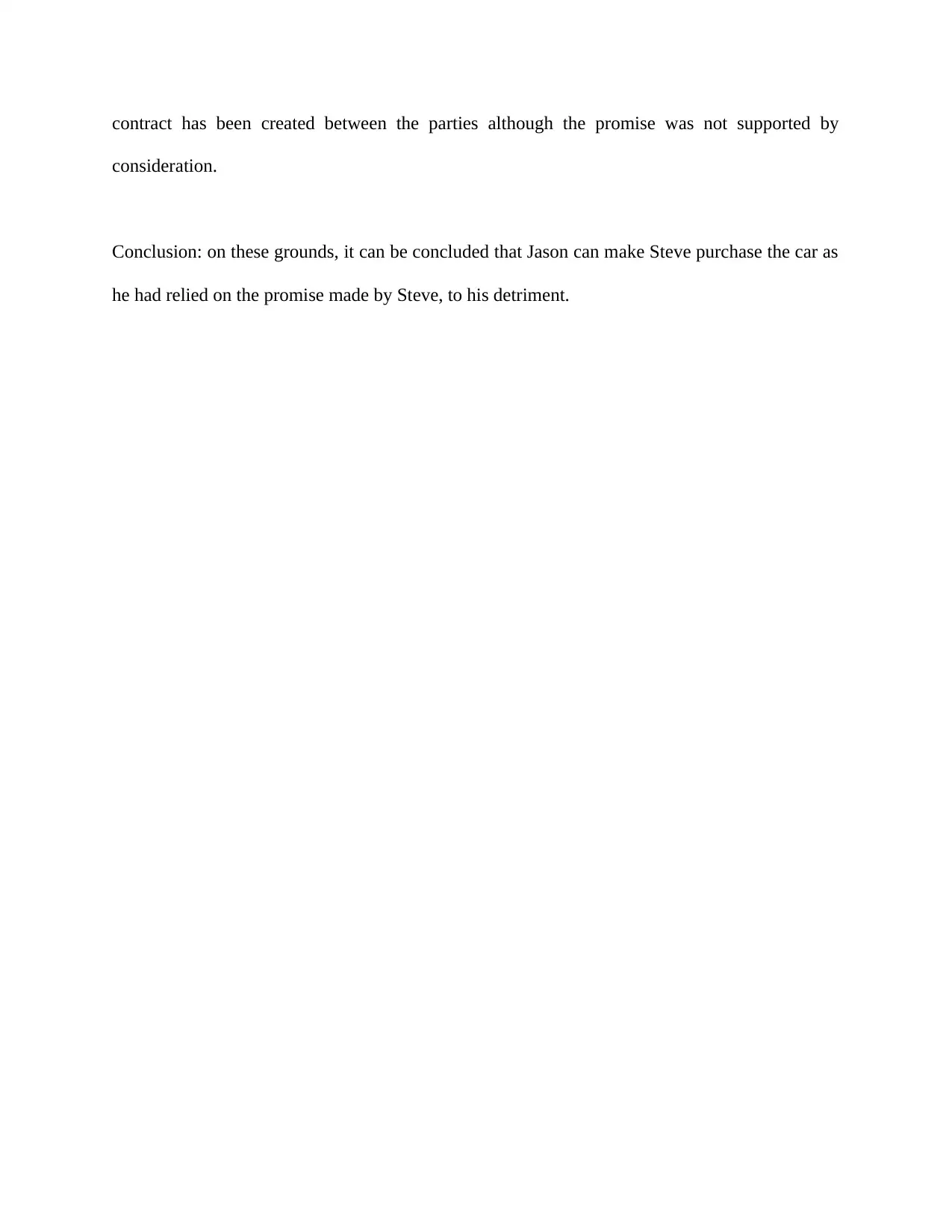
contract has been created between the parties although the promise was not supported by
consideration.
Conclusion: on these grounds, it can be concluded that Jason can make Steve purchase the car as
he had relied on the promise made by Steve, to his detriment.
consideration.
Conclusion: on these grounds, it can be concluded that Jason can make Steve purchase the car as
he had relied on the promise made by Steve, to his detriment.
Paraphrase This Document
Need a fresh take? Get an instant paraphrase of this document with our AI Paraphraser
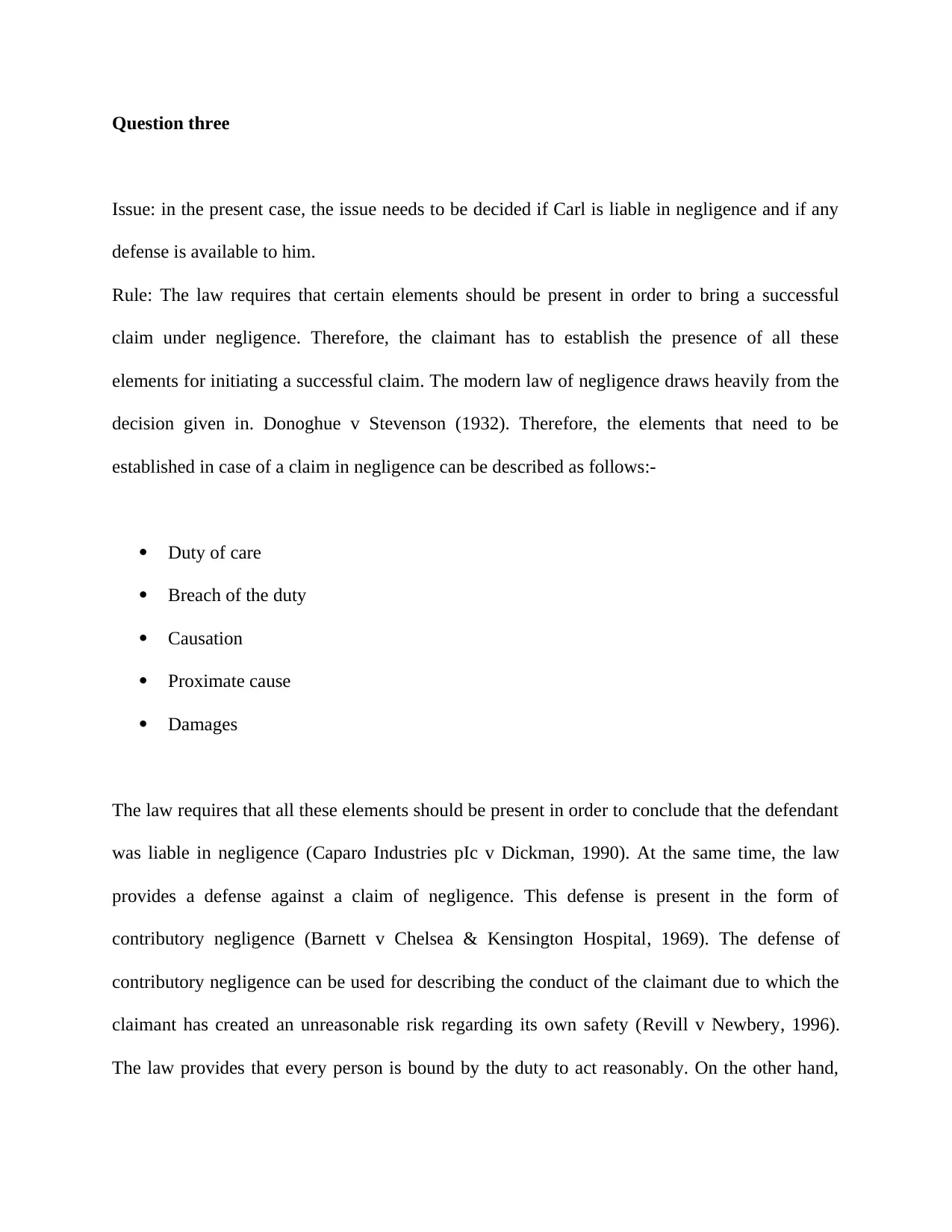
Question three
Issue: in the present case, the issue needs to be decided if Carl is liable in negligence and if any
defense is available to him.
Rule: The law requires that certain elements should be present in order to bring a successful
claim under negligence. Therefore, the claimant has to establish the presence of all these
elements for initiating a successful claim. The modern law of negligence draws heavily from the
decision given in. Donoghue v Stevenson (1932). Therefore, the elements that need to be
established in case of a claim in negligence can be described as follows:-
Duty of care
Breach of the duty
Causation
Proximate cause
Damages
The law requires that all these elements should be present in order to conclude that the defendant
was liable in negligence (Caparo Industries pIc v Dickman, 1990). At the same time, the law
provides a defense against a claim of negligence. This defense is present in the form of
contributory negligence (Barnett v Chelsea & Kensington Hospital, 1969). The defense of
contributory negligence can be used for describing the conduct of the claimant due to which the
claimant has created an unreasonable risk regarding its own safety (Revill v Newbery, 1996).
The law provides that every person is bound by the duty to act reasonably. On the other hand,
Issue: in the present case, the issue needs to be decided if Carl is liable in negligence and if any
defense is available to him.
Rule: The law requires that certain elements should be present in order to bring a successful
claim under negligence. Therefore, the claimant has to establish the presence of all these
elements for initiating a successful claim. The modern law of negligence draws heavily from the
decision given in. Donoghue v Stevenson (1932). Therefore, the elements that need to be
established in case of a claim in negligence can be described as follows:-
Duty of care
Breach of the duty
Causation
Proximate cause
Damages
The law requires that all these elements should be present in order to conclude that the defendant
was liable in negligence (Caparo Industries pIc v Dickman, 1990). At the same time, the law
provides a defense against a claim of negligence. This defense is present in the form of
contributory negligence (Barnett v Chelsea & Kensington Hospital, 1969). The defense of
contributory negligence can be used for describing the conduct of the claimant due to which the
claimant has created an unreasonable risk regarding its own safety (Revill v Newbery, 1996).
The law provides that every person is bound by the duty to act reasonably. On the other hand,
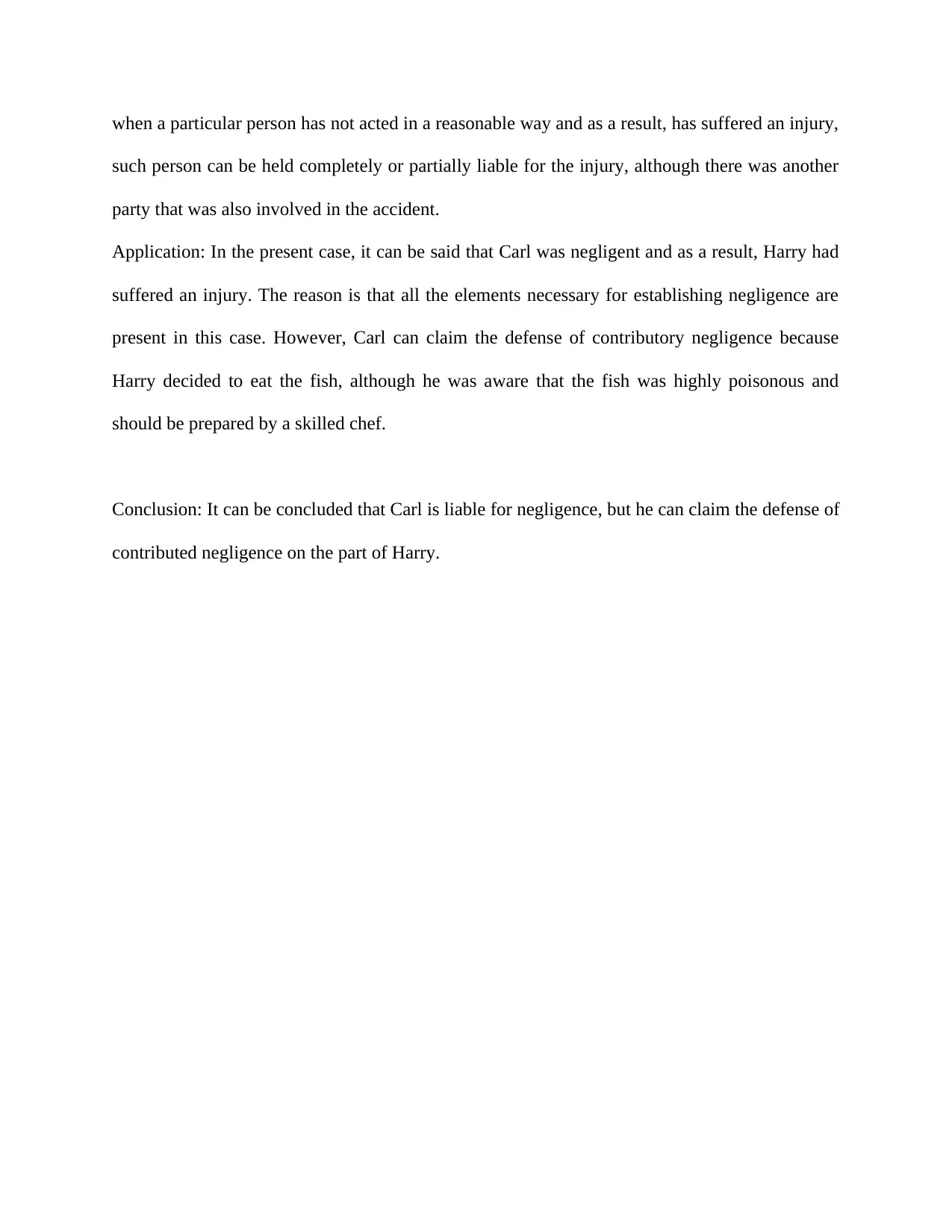
when a particular person has not acted in a reasonable way and as a result, has suffered an injury,
such person can be held completely or partially liable for the injury, although there was another
party that was also involved in the accident.
Application: In the present case, it can be said that Carl was negligent and as a result, Harry had
suffered an injury. The reason is that all the elements necessary for establishing negligence are
present in this case. However, Carl can claim the defense of contributory negligence because
Harry decided to eat the fish, although he was aware that the fish was highly poisonous and
should be prepared by a skilled chef.
Conclusion: It can be concluded that Carl is liable for negligence, but he can claim the defense of
contributed negligence on the part of Harry.
such person can be held completely or partially liable for the injury, although there was another
party that was also involved in the accident.
Application: In the present case, it can be said that Carl was negligent and as a result, Harry had
suffered an injury. The reason is that all the elements necessary for establishing negligence are
present in this case. However, Carl can claim the defense of contributory negligence because
Harry decided to eat the fish, although he was aware that the fish was highly poisonous and
should be prepared by a skilled chef.
Conclusion: It can be concluded that Carl is liable for negligence, but he can claim the defense of
contributed negligence on the part of Harry.
⊘ This is a preview!⊘
Do you want full access?
Subscribe today to unlock all pages.

Trusted by 1+ million students worldwide
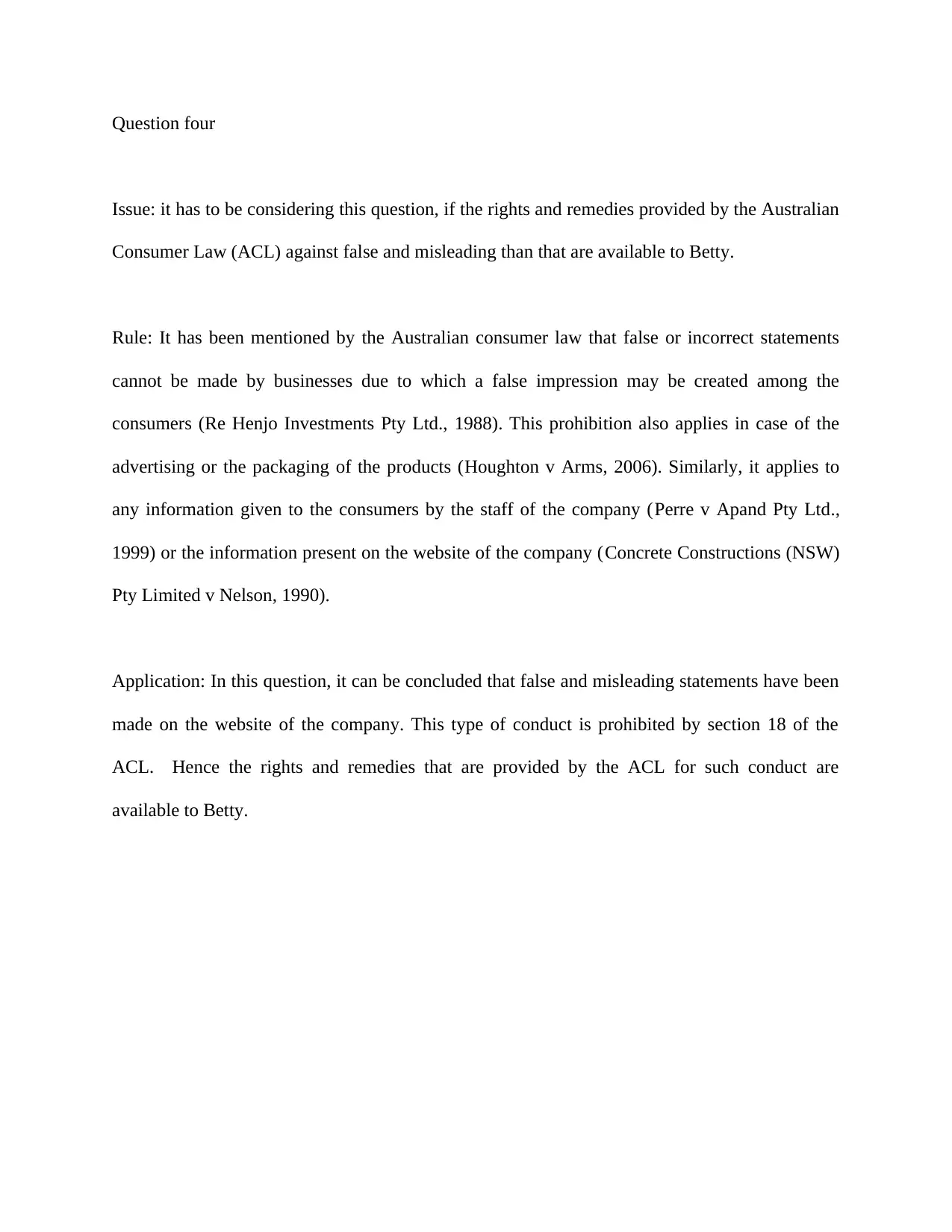
Question four
Issue: it has to be considering this question, if the rights and remedies provided by the Australian
Consumer Law (ACL) against false and misleading than that are available to Betty.
Rule: It has been mentioned by the Australian consumer law that false or incorrect statements
cannot be made by businesses due to which a false impression may be created among the
consumers (Re Henjo Investments Pty Ltd., 1988). This prohibition also applies in case of the
advertising or the packaging of the products (Houghton v Arms, 2006). Similarly, it applies to
any information given to the consumers by the staff of the company (Perre v Apand Pty Ltd.,
1999) or the information present on the website of the company (Concrete Constructions (NSW)
Pty Limited v Nelson, 1990).
Application: In this question, it can be concluded that false and misleading statements have been
made on the website of the company. This type of conduct is prohibited by section 18 of the
ACL. Hence the rights and remedies that are provided by the ACL for such conduct are
available to Betty.
Issue: it has to be considering this question, if the rights and remedies provided by the Australian
Consumer Law (ACL) against false and misleading than that are available to Betty.
Rule: It has been mentioned by the Australian consumer law that false or incorrect statements
cannot be made by businesses due to which a false impression may be created among the
consumers (Re Henjo Investments Pty Ltd., 1988). This prohibition also applies in case of the
advertising or the packaging of the products (Houghton v Arms, 2006). Similarly, it applies to
any information given to the consumers by the staff of the company (Perre v Apand Pty Ltd.,
1999) or the information present on the website of the company (Concrete Constructions (NSW)
Pty Limited v Nelson, 1990).
Application: In this question, it can be concluded that false and misleading statements have been
made on the website of the company. This type of conduct is prohibited by section 18 of the
ACL. Hence the rights and remedies that are provided by the ACL for such conduct are
available to Betty.
Paraphrase This Document
Need a fresh take? Get an instant paraphrase of this document with our AI Paraphraser
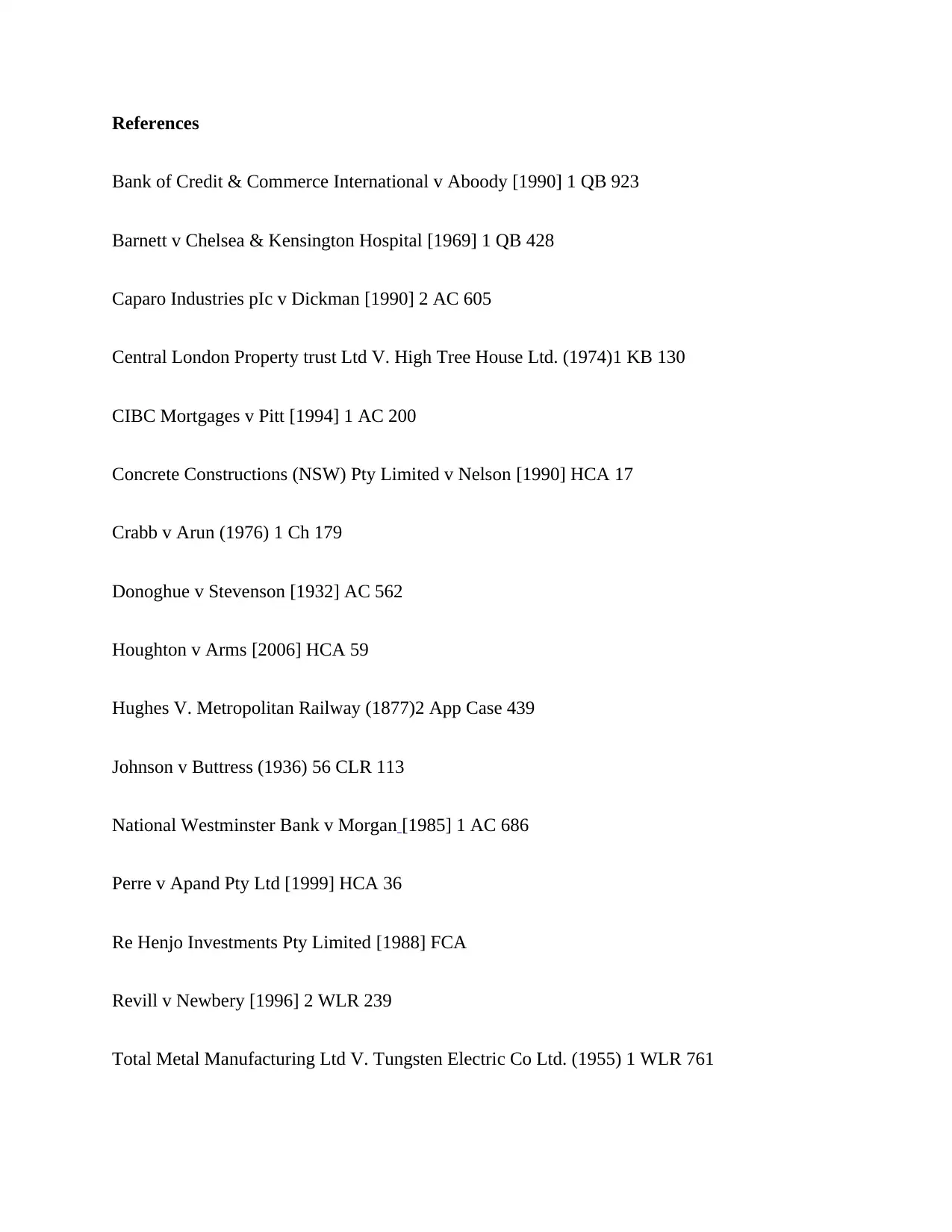
References
Bank of Credit & Commerce International v Aboody [1990] 1 QB 923
Barnett v Chelsea & Kensington Hospital [1969] 1 QB 428
Caparo Industries pIc v Dickman [1990] 2 AC 605
Central London Property trust Ltd V. High Tree House Ltd. (1974)1 KB 130
CIBC Mortgages v Pitt [1994] 1 AC 200
Concrete Constructions (NSW) Pty Limited v Nelson [1990] HCA 17
Crabb v Arun (1976) 1 Ch 179
Donoghue v Stevenson [1932] AC 562
Houghton v Arms [2006] HCA 59
Hughes V. Metropolitan Railway (1877)2 App Case 439
Johnson v Buttress (1936) 56 CLR 113
National Westminster Bank v Morgan [1985] 1 AC 686
Perre v Apand Pty Ltd [1999] HCA 36
Re Henjo Investments Pty Limited [1988] FCA
Revill v Newbery [1996] 2 WLR 239
Total Metal Manufacturing Ltd V. Tungsten Electric Co Ltd. (1955) 1 WLR 761
Bank of Credit & Commerce International v Aboody [1990] 1 QB 923
Barnett v Chelsea & Kensington Hospital [1969] 1 QB 428
Caparo Industries pIc v Dickman [1990] 2 AC 605
Central London Property trust Ltd V. High Tree House Ltd. (1974)1 KB 130
CIBC Mortgages v Pitt [1994] 1 AC 200
Concrete Constructions (NSW) Pty Limited v Nelson [1990] HCA 17
Crabb v Arun (1976) 1 Ch 179
Donoghue v Stevenson [1932] AC 562
Houghton v Arms [2006] HCA 59
Hughes V. Metropolitan Railway (1877)2 App Case 439
Johnson v Buttress (1936) 56 CLR 113
National Westminster Bank v Morgan [1985] 1 AC 686
Perre v Apand Pty Ltd [1999] HCA 36
Re Henjo Investments Pty Limited [1988] FCA
Revill v Newbery [1996] 2 WLR 239
Total Metal Manufacturing Ltd V. Tungsten Electric Co Ltd. (1955) 1 WLR 761
1 out of 8
Related Documents
Your All-in-One AI-Powered Toolkit for Academic Success.
+13062052269
info@desklib.com
Available 24*7 on WhatsApp / Email
![[object Object]](/_next/static/media/star-bottom.7253800d.svg)
Unlock your academic potential
Copyright © 2020–2025 A2Z Services. All Rights Reserved. Developed and managed by ZUCOL.


![Management Law 2 Assignment - [University Name] - Semester 2](/_next/image/?url=https%3A%2F%2Fdesklib.com%2Fmedia%2Fimages%2Foc%2F38e706355e0d4bf19ce1377653715513.jpg&w=256&q=75)


